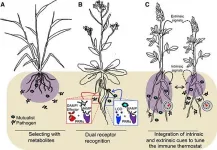How do plants balance microbial friends and foes?
2021-06-10
(Press-News.org) Plants are constantly exposed to microbes: pathogens that cause disease, commensals that cause no harm or benefit, and mutualists that promote plant growth or help fend off pathogens. For example, most land plants can form positive relationships with arbuscular mycorrhizal fungi to improve nutrient uptake. How plants fight off pathogens without also killing beneficial microbes or wasting energy on commensal microbes is a largely unanswered question.
In fact, when scientists within the field of Molecular Plant-Microbe Interactions were asked to come up with their Top 10 Unanswered Questions, the #1 question was "How do plants engage with beneficial microorganisms while at the same time restricting pathogens?" Put more simply, how do plants tell good microbes from bad and what do they do about it? As part of a Top10MPMI review series in the open access MPMI Journal, this question of how plants and microbes engage in symbiosis was recently interrogated by Dr. Cara Haney and Dr. David Thoms, microbiologists at the University of British Columbia, in collaboration with Dr. Yan Liang at Zhejiang University in China.
"Maintaining a balance in plant disease resistance where plants can fight off pests and pathogens but still engage with microbes that can help with nutrient uptake is essential for the health of our crops," emphasizes Haney. To fully engage with such a large question, paradigms are needed to drive specific research questions towards the unanswered pieces. As Haney says, "this question is so broad, I think the review raises more questions than it answers. We attempted to highlight much of what was known, but also what wasn't known and to provide paradigms and models that could be frameworks going forward." In a proposed framework for considering mechanisms of symbiotic engagement, Haney, Thoms, and Liang distinguish three principles: chemical selection with metabolites, dual receptor recognition, and tuning of an immune thermostat.
Plants first use metabolite compounds like antimicrobials and chemical signals to recruit beneficial organisms and restrict pathogens, but not all pathogens are excluded. Once plant and microbe are in contact, Thoms proposes that "a dual input model" is used by the plant to distinguish both the type of microbe (bacterial, fungal, or nematode) and the lifestyle (mutualist, commensal, or pathogen). Microbes can be detected by receptor proteins on the surface of plant cells. When receptor proteins detect a piece of fungal cell wall known as chitin, the plant discovers a fungal microbe is present. But as chitin, and other microbe-associated molecular patterns (MAMPS), are often shared among microbes, they are insufficient signals to distinguish commensals from pathogens according to Thoms.
"Unlike most animals, plants do not have an adaptive immune system. However, plant genomes contain many more innate immune receptors than animals," Liang explains. "Plants also use similar receptors to sense signaling molecules from beneficial microbes, environments, as well as their own cells." So, additional receptors use a second layer of information to identify pathogens versus mutualists. Symbiosis receptors can identify signaling molecules specifically produced by beneficial microbes, while immune receptors can identify pathogen proteins intended to shut down plant defense. Addressing the need to know both the type and lifestyle of a microbe, Thoms remarks, "I think it's cool that plants can perceive so many types of MAMPs across different kingdoms of life and I think one use of that is recognizing where the microbe is coming from to give the appropriate physiological response." Essentially, a plant cell follows a flowchart to determine what reaction is needed in response to the type and lifestyle of microbe it perceives.
Yet, a plant can simultaneously engage with multiple microbes that require different responses, making it more complicated than following the flowchart directly. Energy use for immunity and symbiosis must be balanced based on present microbes and current plant needs. So, the remaining piece of the story is a "normal immune setpoint." "It is important to understand what this is and how it can be adjusted over a plant's life in order to maximize yields of our crops," explain Haney. Because of the impact of the environment and nutrient stress as well, how plants decide to use resources to engage in symbiosis or prevent infection is perhaps one of the biggest areas for exploration.
How to identify and respond to different microbes in variable environments is not a problem unique to plants. "Many living things, ranging from plants to humans, are faced with the challenge of engaging with beneficial microbes while restricting pathogens," highlights Haney. "As a result, paradigms in plant-microbe interactions may shed light on eukaryotic interactions with microbes in diverse organisms."
INFORMATION:
Read more in "Maintaining Symbiotic Homeostasis: How Do Plants Engage With Beneficial Microorganisms While at the Same Time Restricting Pathogens?" This article is part of the Top 10 Unanswered Questions invited review series in MPMI. See the list of the top 10 unanswered questions. You can also watch Drs. Cara Haney and David Thoms present on this review article in their free virtual seminar.
[Attachments] See images for this press release:

ELSE PRESS RELEASES FROM THIS DATE:
2021-06-10
MORGANTOWN, W.Va. -- Imagine being woken up at 3 a.m. to navigate a corn maze, memorize 20 items on a shopping list or pass your driver's test.
According to a new analysis out of West Virginia University, that's often what it's like to be a rodent in a biomedical study. Mice and rats, which make up the vast majority of animal models, are nocturnal. Yet a survey of animal studies across eight behavioral neuroscience domains showed that most behavioral testing is conducted during the day, when the rodents would normally be at rest.
"There are these dramatic daily fluctuations--in metabolism, in immune function, in learning and ...
2021-06-10
Philadelphia, June 10, 2021 - The collection of nasopharyngeal swab (NPS) samples for COVID-19 diagnostic testing poses challenges including exposure risk to healthcare workers and supply chain constraints. Saliva samples are easier to collect but can be mixed with mucus or blood, and some studies have found they produce less accurate results. A team of researchers has found that an innovative protocol that processes saliva samples with a bead mill homogenizer before real-time PCR (RT-PCR) testing results in higher sensitivity compared to NPS samples. Their protocol appears in The Journal of Molecular Diagnostics, published by Elsevier.
"Saliva as a sample type for COVID-19 testing ...
2021-06-10
WASHINGTON, June 10, 2021 -- The demand for flexible wearable electronics has spiked with the dramatic growth of smart devices that can exchange data with other devices over the internet with embedded sensors, software, and other technologies. Researchers consequently have focused on exploring flexible energy storage devices, such as flexible supercapacitators (FSCs), that are lightweight and safe and easily integrate with other devices. FSCs have high power density and fast charge and discharge rates.
Printing electronics, manufacturing electronics devices and systems by using conventional printing techniques, has proved to be an economical, simple, and scalable strategy for fabricating FSCs. Traditional micromanufacturing ...
2021-06-10
An exploratory investigation into the behavior of materials with desirable electric properties resulted in the discovery of a structural phase of two-dimensional (2D) materials. The new family of materials are electrides, wherein electrons occupy a space usually reserved for atoms or ions instead of orbiting the nucleus of an atom or ion. The stable, low-energy, tunable materials could have potential applications in nanotechnologies.
The international research team, led by Hannes Raebiger, associate professor in the Department of Physics at Yokohama National University in Japan, published their results on June 10th as frontispiece in Advanced Functional Materials.
Initially, the team ...
2021-06-10
Researchers from Skoltech have designed and conducted experiments measuring gas permeability under various conditions for ice-containing sediments mimicking permafrost. Their results can be useful both in modeling and testing techniques for gas production from Arctic reservoirs and in tracing methane emission in high latitudes. The paper was published in the journal Energy&Fuels.
Permafrost, even though it sounds very stable and permanent, is actually quite diverse: depending on the composition of the frozen ground, pressure, temperature and so on, it can have varying properties, which are extremely important if you want to build something on permafrost, ...
2021-06-10
GRAND RAPIDS, Mich. (JUNE 10, 2021) -- Much like a supply truck crossing the countryside, the misfolded proteins that damage neurons in Alzheimer's disease travel the "roads" of the brain, sometimes stopping and sometimes re-routing to avoid roadblocks, reports a study published in END ...
2021-06-10
MELVILLE, N.Y., June 10, 2021 -- The physiological impacts of COVID-19 seem almost limitless. Complications can range from loss of taste to respiratory distress, with many effects lasting for months. Evidence suggests auditory and vestibular effects should be added to the growing list of symptoms.
During the 180th Meeting of the Acoustical Society of America, which will be held virtually June 8-10, Colleen Le Prell, from the University of Texas at Dallas, will talk about hearing and balance disorders associated with coronavirus infection and how pandemic-related stress ...
2021-06-10
Paris, France and New York, NY June 10, 2021 - AP-HP Greater Paris University Hospitals, the leading European clinical trial center with the largest amount of healthcare data in France dedicated to research and Owkin, a startup pioneering Federated Learning and AI technologies for medical research and clinical development, announced the recent results of their ongoing strategic collaboration at ASCO 2021. The abstract and poster entitled "Identification of pancreatic adenocarcinoma molecular subtypes on histology slides using deep learning models" demonstrates the first ...
2021-06-10
ROCKVILLE, Md. - June 10, 2021 - The Association for Molecular Pathology (AMP), the premier global, molecular diagnostic professional society, today published consensus recommendations to aid in the design and validation of clinical CYP2D6 assays, promote standardization of testing across different laboratories and improve patient care. The manuscript, "Recommendations for Clinical CYP2D6 Genotyping Allele Selection: A Joint Consensus Recommendation of the Association for Molecular Pathology, College of American Pathologists, Dutch Pharmacogenetics Working Group of the Royal Dutch Pharmacists Association, and European Society for Pharmacogenomics and Personalized Therapy," was released online ahead of publication in The Journal ...
2021-06-10
Champaign, IL, June 10, 2021 - Present in blood, urine, and milk, the chemical compound urea is the primary form of nitrogen excretion in mammals. Testing for urea levels in dairy cows helps scientists and farmers understand how effectively nitrogen from feed is used in cows' bodies, with important economic implications for farmers in terms of feed costs, physiological effects for cows such as reproductive performance, and environmental impacts from excretion of nitrogen in dairy cow waste. Thus, accuracy in testing dairy cow urea levels is essential.
Since the 1990s, mid-infrared testing of milk urea nitrogen (MUN) has been the most efficient and least invasive way to measure nitrogen use by dairy cows in large numbers. In a recent ...
LAST 30 PRESS RELEASES:
[Press-News.org] How do plants balance microbial friends and foes?




